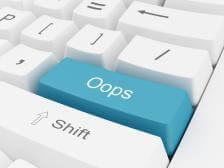Don’t Make These Email Mistakes!
Have you ever gotten an email that made you want to lose your cool? The Public Speaker explains how to maintain professionalism and avoid embarrassing email exchanges that might get you into hot water.
Lisa B. Marshall
Listen
Don’t Make These Email Mistakes!
Kelly Blazek, a Senior Communications Executive and head of a popular local job bank listserv, received an email request from a recent graduate named Diana Mekota, Ms. Blazek felt the requester was asking for too much–so she dashed off an angry response. Unfortunately for her, the reply quickly went viral..

“Your invite to connect is inappropriate, beneficial only to you, and tacky.”
“Wow, I cannot wait to let every 25-year-old jobseeker mine my top-tier marketing connections to help them land a job.”
“You’re welcome for your humility lesson for the year.. Don’t ever reach out to senior practitioners again and assume their carefully curated list of connections is available to you, because you want to build your network.”
Her response was picked up by several social media blogs and caused a huge backlash for Kelly Blazek. She offered an apology, but the damage had already been done.
I’m not taking sides here; I could probably do an entire podcast on what Diane Mekota did wrong, too. But right now I want to talk about how to keep your cool in emails and protect your reputation.
Don’t Respond When You’re Frustrated
I’m sure we’ve all received an email or two that has made us angry. I think I receive at least three hostile emails a month! Just don’t respond to these when you’re frustrated. You are bound to react emotionally, and you’ll probably end up regretting it.
I try to make a game of it. I have a running contest for “worst emails,” and when I get a real doozy, I send it to several people. By making a game of it, it helps me to get some distance from negative emotion, and sometimes I even end-up laughing about the messages.
Take a Break

It is so easy to come across as cold or angry without realizing it, so it is important to read your response with fresh eyes. or talk to someone else about what you have planned to say. They may help you shape your response.
Also, during the break you’ll want to consider if your response will make a difference or not. Will responding help the receiver or the situation in any way? If it’s a one-time issue, never to be repeated, it’s best just to leave it be. Or if no matter what you say, the situation can’t be changed, then it might be best to let things rest without a response. I know that is probably easier said than done!
Use Pre-Written Responses
If this is something that will be repeated, or your response would be helpful in the future, then go ahead and respond. I use a product called Text Expander that allows me to store pre-written responses to different subjects.
For example, I used to get frustrated by people sending me angry messages regarding printouts from their printers. On certain printers, if a selection is made on the panel, the printer will automatically print content from my company on a scheduled basis. Because this technology is so new, many people don’t realize what it is, or understand that they themselves selected the setting. Instead, they get upset–and think I am sending them spam faxes.

Skip the “Snark”
If you are responding on the fly, be careful about using rhetorical questions, especially “snarky” ones. Even really simple phrases can sound ugly. This is especially true when questions are conveyed via email.
For example, here’s another line from Kelly Blazek’s email. When I use the word “snark”, this is what I’m talking about:
“Oh, and about your request to actually receive my Job Bank along with the 7,300 other subscribers to my service? That’s denied, too….I suggest you join the other Job Bank in town Oh wait- there isn’t one.”
Perhaps a more educational response would have been better. Something like, “I’d love to provide you access to my Job Bank. You just need to subscribe to my service. Here’s how to do it.”
Avoid Loaded Questions
I recently read a book entitled, Stop Talking, Start Communicating, by Geoffrey Tumlin. (I also interviewed him on my Smart Talk podcast.) In his book, Tumlin warns that we should stay away from ”loaded” questions.
These type of questions are really just a lightly-veiled form of criticism. For example, asking, “Is that what you normally do?,” suggests something is wrong with the way someone is choosing to handle a task. Similarly, you should also avoid rhetorical questions, such as, “Is that the best you can do?” These questions are simply mean-spirited and not helpful.
Don’t make the mistake Kelly Blazek made. She didn’t just do this once either–at least three people came forward with similar responses from her. Not only has she had to apologize multiple times, she shut down her popular listserv, deleted her blog, LinkedIn, and Twitter accounts, and had to give back the “Cleveland Communicator of the Year” award she’d just won.
No matter how upset you may be with an email, a rash response is not worth the repercussions that might come with it.. So the next time you get a nasty email, the first thing you should do is…read this article again!
This is Lisa B. Marshall, Helping you maximize sales, manage perceptions, and enhance leadership through keynotes, workshops, books, and online courses. Passionate about communication; your success is my business. If you want even more success in your life, I invite you to listen to my other podcast, Smart Talk: Inspiring Conversations with Exceptional People.
Photos of woman with phone, Oops key, and woman on laptop courtesy of Shutterstock.

